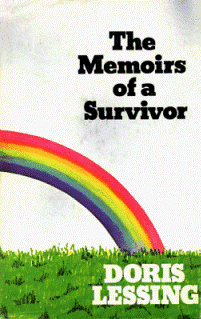Memoirs of a Survivor
 UK first edition | |
| Author | Doris Lessing |
|---|---|
| Language | English |
| Publisher | Octagon Press |
Publication date | 1974 |
| ISBN | 0-900860-30-8 |
| OCLC | 1208042 |
| 823/.9/14 | |
| LC Class | PR6023.E833 M4 PR6023.E833 |
The Memoirs of a Survivor is a dystopian novel by Nobel Prize-winner Doris Lessing. It was first published in 1974 by Octagon Press. It was made into a film in 1981, starring Julie Christie and Nigel Hawthorne, and directed by David Gladwell.
Plot
The story takes place in a near-future Britain where society has broken down due to an unspecified disaster. Family units themselves have broken down and survivors band together into loose units for basic survival.
The unnamed narrator ends up with 'custody' of a teenage girl named Emily Cartwright. Emily herself has unspecified trauma in her past that the main character does not probe at. Hugo, an odd mix of cat and dog, comes with Emily. Due to the growing scarcity of resources, the animal is in constant danger of being eaten.
Periodically, the narrator is able, through meditating on a certain wall in her flat, to traverse space and time. Many of these visions are about Emily's sad childhood under the care of her harsh father and distant mother. At the end of the novel, the main character's strange new family breaks through dimensional barriers via the wall, and walks into a much better world.
Concept and creation
Author Doris Lessing says this novel grew out of a "very hubristic" ambition to write an autobiography in dreams.[1]
According to Jenny Diski, Emily is partly based on Diski, who lived with Lessing for some years as an adolescent.[2]
Reception
"Doris Lessing is not afraid to break through the barrier separating the mainstream from the fantastic, to let go of man's world," writes Marleen S. Barr in her essay in A Companion to Science Fiction. She argues that feminist science fiction novels such as Memoirs of a Survivor provide an alternate viewpoint that "dissolve walls that imprison women within a sexist reality."[3] However, the warping of space and time presented in this novel led scholar Betsy Draine to label it a "failure", saying the shifts between realistic and mystical frames are impossible to follow.[4] The New York Review of Books felt the ending, in which Emily leads the other main characters through the walls into another reality, was "reminiscent of a Technicolor fade-out into the sunset."[5]
Themes
The New York Times wrote, "Lessing's message, recognizable from her previous work, is close to W. H. Auden's 'We must love one another or die'." Although we will inevitably be defeated and disillusioned, we still need to care about other people.[6]
Consciousness becomes a physical boundary represented by the wall of the narrator's home: "the rooms and garden beyond it are areas of the unconscious which she explores."[7] The mystical dimension is given the author's tacit approval when she allows the principal characters to escape the dystopian reality by passing through the wall.[8]
Another theme is that of breakdown, both of mechanized Western culture and of adult, mechanical personality.[5]
References
- ↑ Sperlinger, Tom (October 10, 2007), "An Interview with Doris Lessing", The Reader (17)
- ↑ Jenny Diski (8 January 2015). "Doris and Me". London Review of Books.
- ↑ Marleen S. Barr (2005). "Feminist Fabulation". In David Seed. A Companion to Science Fiction. Wiley-Blackwell. p. 146. ISBN 1-4051-1218-2.
- ↑ Greene, Gayle (1994), Doris Lessing, University of Michigan Press, p. 146, ISBN 0-472-10568-X
- 1 2 Dinnage, Rosemary (July 17, 1975), In the Disintegrating City, 22 (12), The New York Review of Books
- ↑ Howard, Maureen (June 8, 1975), "Doris Lessing Considers Her World and the World", The New York Times
- ↑ Hague, Angela (2003), Fiction, intuition, & creativity, CUA Press, pp. 284–286, ISBN 0-8132-1314-2
- ↑ Brigg, Peter (2002), The span of mainstream and science fiction: a critical study of a new literary genre, McFarland, p. 33, ISBN 0-7864-1304-2
.jpg)